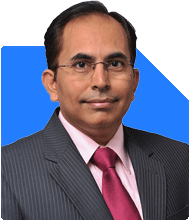Can I retire at 50 with 10 cr? I'm 38 with 1.3 lakh monthly earning.
Ramalingam Kalirajan |10881 Answers |Ask -Follow
Mutual Funds, Financial Planning Expert - Answered on Nov 01, 2024
He has an MBA in finance from the University of Madras and is a certified financial planner.
He is the director and chief financial planner at Holistic Investment, a Chennai-based firm that offers financial planning and wealth management advice.... more

I am 38 years old. I want to retire at 50 with 10 cr corpus. Currently i have 8 lks in ppf. 10lks in fixed. 3lks in MF. 4 lks in NPS. Immovable property 1 cr. Monthly earning 1.3 lks. Can you give me a plan.
Understanding Your Current Financial Snapshot
Age: 38 years
Target Corpus: Rs 10 crore by age 50
Current Assets:
PPF: Rs 8 lakhs
Fixed Deposits (FDs): Rs 10 lakhs
Mutual Funds (MFs): Rs 3 lakhs
National Pension System (NPS): Rs 4 lakhs
Property: Rs 1 crore (Real estate for residence use, not for investment growth)
Monthly Income: Rs 1.3 lakhs
Retirement Planning Components
Calculating Investment Needs
To reach Rs 10 crore in 12 years, you’ll need an aggressive yet diversified investment plan. Your current holdings are strong but will need to grow substantially.
Future Income Need and Inflation
Factor in inflation to ensure the corpus sustains your lifestyle post-retirement. Rs 10 crore may sound sufficient, but inflation could erode its value.
Monthly Investment Plan
A significant portion of your current earnings should be directed toward high-growth investments. We’ll discuss suitable options below.
Building a Retirement Corpus with Strategic Investments
Let's go through options that align with your current portfolio, income, and retirement goal.
Public Provident Fund (PPF)
Current Balance: Rs 8 lakhs
Growth Potential: PPF grows at a steady rate, with tax-free maturity.
Annual Contribution: Consider maximizing the Rs 1.5 lakh limit under Section 80C each year.
PPF is a low-risk asset, and it’s great for building a safe, tax-efficient base. However, PPF alone won’t yield the aggressive growth you need.
Fixed Deposits (FDs)
Current Balance: Rs 10 lakhs
Growth Limitation: FDs offer security but don’t keep pace with inflation.
Consider shifting a portion of your FDs into higher-yielding mutual funds. Retain a portion as a cushion for emergencies, but too much in FDs can limit growth.
Mutual Funds (MFs)
Current Balance: Rs 3 lakhs
Suggested Strategy: Increase allocation to equity mutual funds for higher growth.
Instead of index funds, explore actively managed mutual funds. Actively managed funds offer flexibility and can outperform passive index funds over time.
Balanced Advantage Funds (BAFs): Offer a balance between equity and debt, making them relatively stable while yielding better returns.
Flexi-Cap Funds: These funds invest in large, mid, and small-cap stocks and adapt based on market opportunities. This flexibility provides robust growth over long terms.
Small-Cap Funds: Include some small-cap funds for aggressive growth. Though volatile, they offer high returns if invested with a 10-12 year horizon.
Work with a Certified Financial Planner (CFP) who can select funds tailored to your goals and risk appetite.
National Pension System (NPS)
Current Balance: Rs 4 lakhs
Tax Benefits: NPS contributions qualify for an additional tax deduction under Section 80CCD(1B).
Continue investing in NPS, but consider it as a secondary retirement corpus. NPS has compulsory annuity requirements upon withdrawal, which may limit lump-sum availability. However, the equity exposure in NPS is beneficial for long-term growth.
Enhanced Monthly Investment Strategy
To reach Rs 10 crore, you’ll need to invest more of your Rs 1.3 lakh monthly income. Allocate a set amount monthly to each category:
Mutual Funds: Consider investing Rs 50,000 monthly through SIPs in diversified funds.
PPF/NPS: Maximize annual contributions to PPF (Rs 1.5 lakhs) and maintain a consistent amount in NPS.
Debt Funds: For a stable income, allocate Rs 20,000 monthly toward debt funds. Debt funds offer liquidity with taxation benefits based on your tax bracket.
Avoiding Direct Mutual Fund Investments
While direct funds have lower expense ratios, it’s beneficial to invest in regular funds through a CFP. Certified Financial Planners have insights on fund performance, market cycles, and can manage portfolio rebalancing, essential for an early retirement goal.
Capital Gains Taxation on Mutual Funds
With the new tax rules on equity mutual funds:
Long-Term Capital Gains (LTCG): Gains above Rs 1.25 lakh annually are taxed at 12.5%.
Short-Term Capital Gains (STCG): These gains are taxed at 20%.
For debt mutual funds, both LTCG and STCG are taxed as per your income tax slab.
Building a Balanced Portfolio
Your portfolio should balance equity, debt, and tax-saving avenues:
Equity (Mutual Funds): A 60-70% allocation in equity mutual funds could drive growth.
Debt (PPF, NPS, Debt Funds): Allocate 30-40% to debt instruments for stability and steady returns.
This balance can maximize growth while managing risk, essential for an aggressive timeline like yours.
Retirement Withdrawal Strategy
On retirement, systematic withdrawals can maintain a steady income flow. Using a Systematic Withdrawal Plan (SWP) in mutual funds can provide monthly income and manage tax efficiently.
Adjusting for Inflation
An inflation-adjusted goal is crucial. Given inflation, Rs 10 crore at 50 will retain a similar lifestyle to a lesser amount today.
Final Insights
Achieving Rs 10 crore in 12 years is ambitious but attainable. It requires disciplined investment, a diversified portfolio, and regular reviews with a CFP to stay on track. By maximizing equity exposure, reducing reliance on FDs, and strategic tax planning, you can reach your goal and secure a fulfilling early retirement.
Best Regards,
K. Ramalingam, MBA, CFP,
Chief Financial Planner,
www.holisticinvestment.in
https://www.youtube.com/@HolisticInvestment
You may like to see similar questions and answers below
Ramalingam Kalirajan |10881 Answers |Ask -Follow
Mutual Funds, Financial Planning Expert - Answered on Apr 15, 2024
Ramalingam Kalirajan |10881 Answers |Ask -Follow
Mutual Funds, Financial Planning Expert - Answered on Aug 19, 2024
Ramalingam Kalirajan |10881 Answers |Ask -Follow
Mutual Funds, Financial Planning Expert - Answered on Jan 08, 2025
Janak Patel |71 Answers |Ask -Follow
MF, PF Expert - Answered on Jan 29, 2025
Ramalingam Kalirajan |10881 Answers |Ask -Follow
Mutual Funds, Financial Planning Expert - Answered on Feb 04, 2025
Ramalingam Kalirajan |10881 Answers |Ask -Follow
Mutual Funds, Financial Planning Expert - Answered on Jul 29, 2025
Mayank Chandel |2575 Answers |Ask -Follow
IIT-JEE, NEET-UG, SAT, CLAT, CA, CS Exam Expert - Answered on Dec 13, 2025
Radheshyam Zanwar |6742 Answers |Ask -Follow
MHT-CET, IIT-JEE, NEET-UG Expert - Answered on Dec 13, 2025
Mayank Chandel |2575 Answers |Ask -Follow
IIT-JEE, NEET-UG, SAT, CLAT, CA, CS Exam Expert - Answered on Dec 13, 2025
Mayank Chandel |2575 Answers |Ask -Follow
IIT-JEE, NEET-UG, SAT, CLAT, CA, CS Exam Expert - Answered on Dec 13, 2025
Kanchan Rai |646 Answers |Ask -Follow
Relationships Expert, Mind Coach - Answered on Dec 12, 2025
Ravi Mittal |677 Answers |Ask -Follow
Dating, Relationships Expert - Answered on Dec 12, 2025
Ramalingam Kalirajan |10881 Answers |Ask -Follow
Mutual Funds, Financial Planning Expert - Answered on Dec 12, 2025
Ramalingam Kalirajan |10881 Answers |Ask -Follow
Mutual Funds, Financial Planning Expert - Answered on Dec 12, 2025
Reetika Sharma |423 Answers |Ask -Follow
Financial Planner, MF and Insurance Expert - Answered on Dec 12, 2025
Reetika Sharma |423 Answers |Ask -Follow
Financial Planner, MF and Insurance Expert - Answered on Dec 12, 2025

























